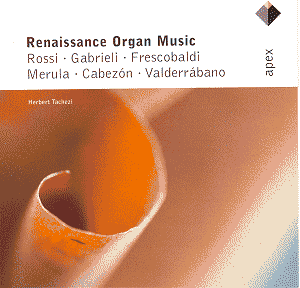The title of this CD is a little misleading.
Some of the composers represented here can hardly be considered
‘renaissance’ any more, like Frescobaldi, Rossi and Merula. In
particular Rossi and also the German composer Christian Erbach
experimented with temperaments in their compositions which – if
played on the appropriate instrument – leads to very sharp dissonances
– a characteristically ‘baroque’ phenomenon.
The repertoire on this recording shows a wide
variety of forms and styles by composers from Italy, Germany,
Austria and Spain. Some of the compositions are original works
for keyboard, some for other instruments, like the Fantasia by
De Valderrabano and the Pavana and Galliarda by De Milan, which
were originally composed for the vihuela. Most keyboard works
can be played on any keyboard instrument. But some are specifically
for the organ because of their liturgical character, like Frescobaldi’s
Toccata per l’Elevazione and the pieces by Michael Praetorius
and Kotter. Tomás de Santa Maria also had a specific instrument
in mind, when he composed his eight Fantasies: they come from
the ‘Libro llamado arte de tañer fantasia’, which is a
tutor on playing the clavichord, and on improvisation.
The booklet doesn’t give any information on the
organs played here. I know the organ from the Hofkirche in Innsbruck
from other recordings. It is from the 16th century, and is tuned
in meantone temperament. The importance of that fact is clearly
audible in the last piece on this CD, the Ricercar 2. toni by
Christian Erbach. The chromaticism in the beginning and at the
end has a much stronger effect than would be the case if the organ
had been tuned in equal temperament. The other piece which aims
at this kind of effect is the Capriccio cromatico by Tarquinio
Merula. But in this case the effect isn’t by far as strong. It
leads me to the assumption that this organ, about which I don’t
know anything and couldn’t find anything in encyclopaedias or
on the Internet, is tuned in a more ‘modern’ temperament.
Although the interpretation by Herbert Tachezi
has in it much to admire and enjoy, I am not always happy with
the choice of repertoire. Playing Italian music on an Austrian
organ isn’t that much of a problem: Austria was strongly under
Italian influence. But there are limitations: pieces to be played
during the elevation, like the ‘Toccata per l’elevazione’ by Frescobaldi,
were usually registered with a ‘piffaro’ or ‘voce umana’, a stop
which is present on any Italian organ of the 16th and 17th century.
No registrations are given, but there certainly is no Italian
‘piffaro’ here, which does mar this work’s character.
Even less satisfying is the choice of pieces
by Spanish composers. Spanish organs were very different from
organs in the rest of Europe, and it is almost impossible to find
stops on – for instance – an Austrian organ which can imitate
the stops on Spanish organs. A typical feature of Spanish organs
are the number of reed stops, like ‘trompeta’, ‘regalia’ and ‘clarín’.
Many organs had a whole battery of ‘clarines’. Another stop which
is on every Spanish organ is the ‘corneta’. All these stops are
missing here. In Luis de Milan’s Pavana and Galliarda Tachezi
uses the ‘Trommeta’ (trumpet stop) of the organ in Innsbruck,
but its sounds is quite different from that of the Spanish reed
stops. And considering the fact that Milan’s pieces were originally
conceived for the vihuela – the Spanish renaissance guitar – one
wonders why on earth Tachezi has chosen to use the trumpet stop
here.
I have mixed feelings about this recording. It
is disappointing that the booklet is so short on information about
the music and, even more, about the organs, since I think it is
the instruments which make this recording interesting.
Many pieces on this CD have been recorded elsewhere,
and probably better. That doesn’t mean Tachezi’s playing is bad
– not at allv - but there is more in this music than he delivers.
Johan van Veen

